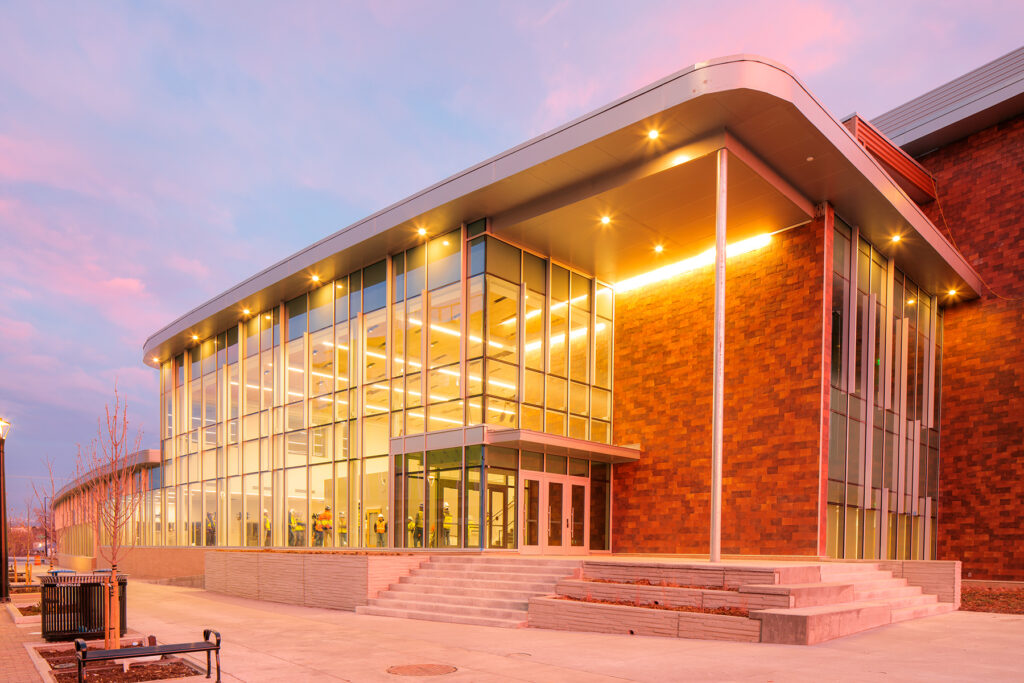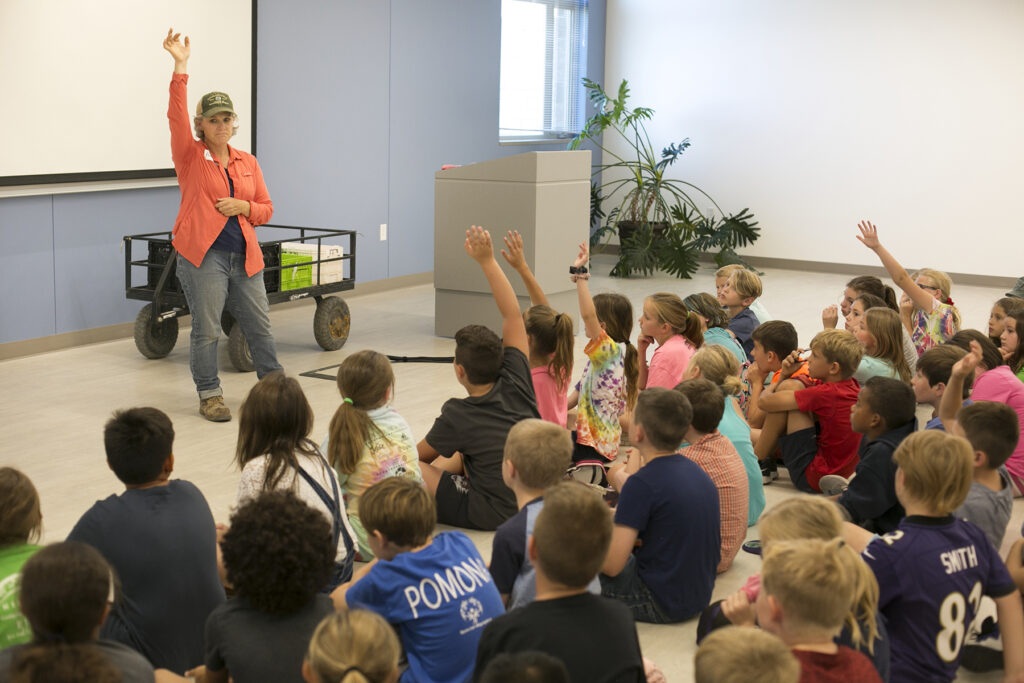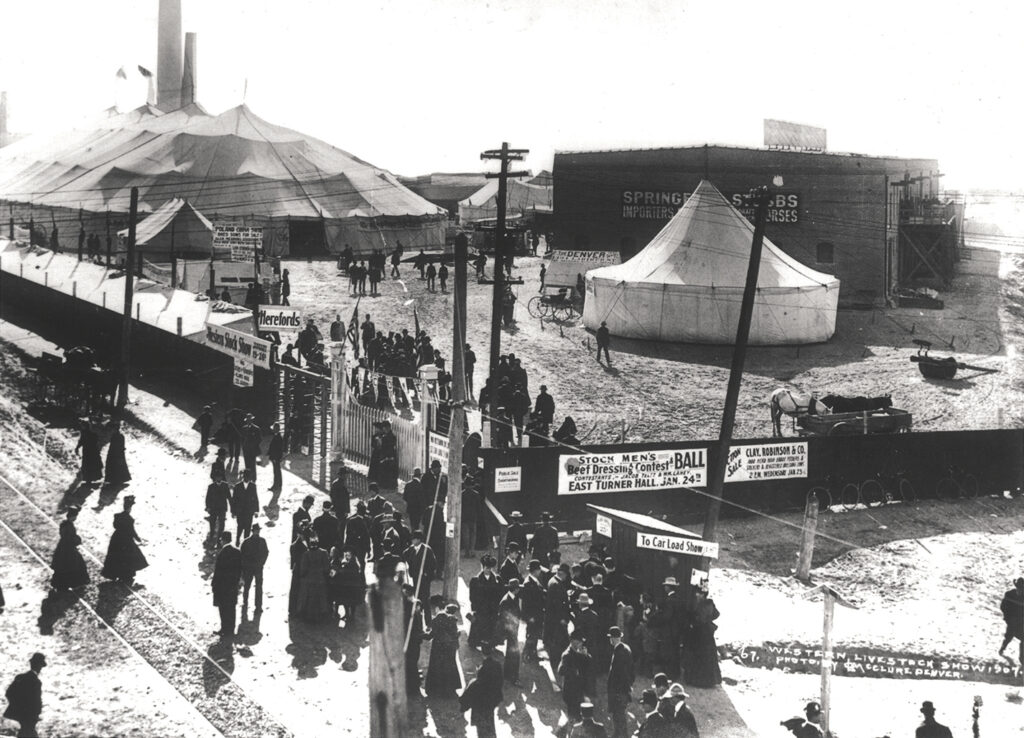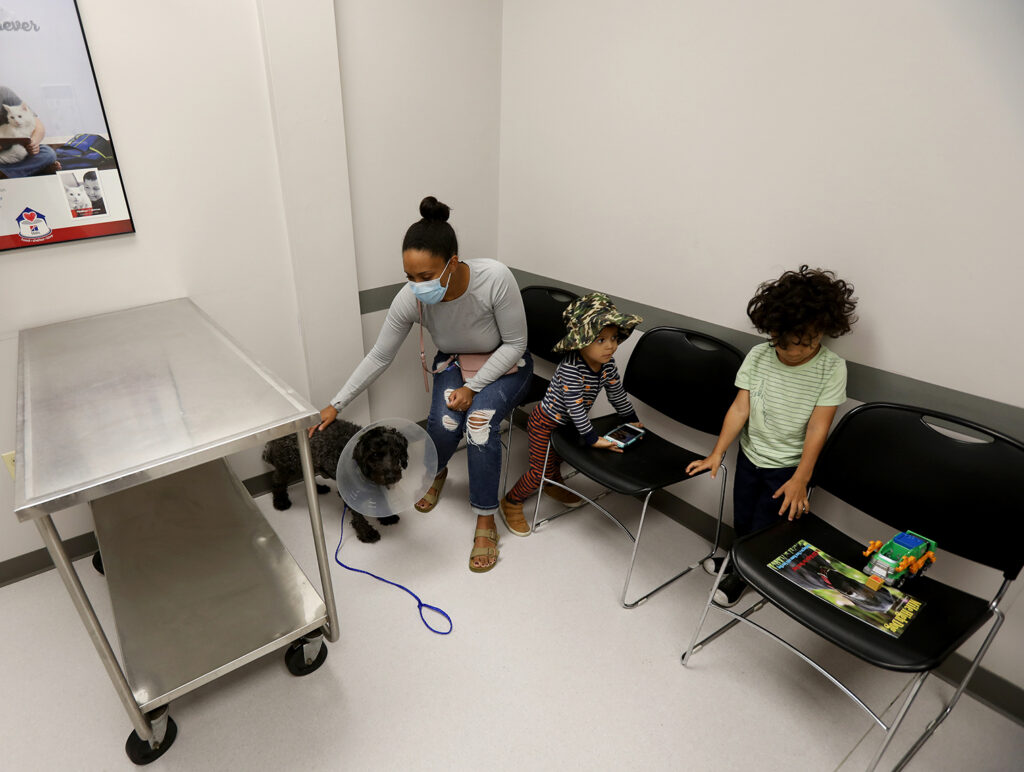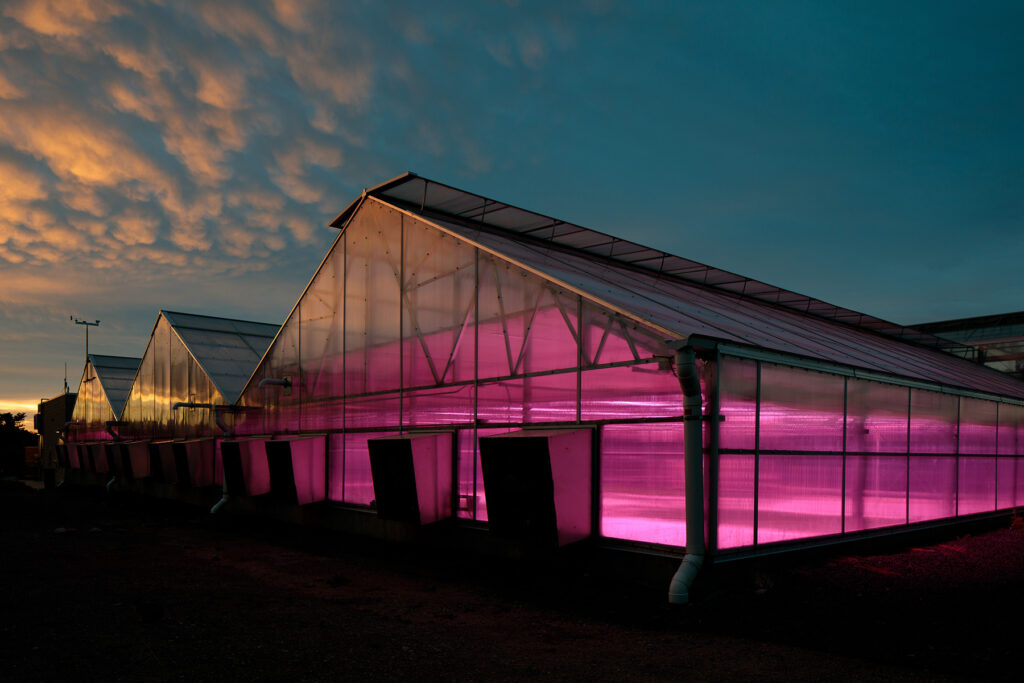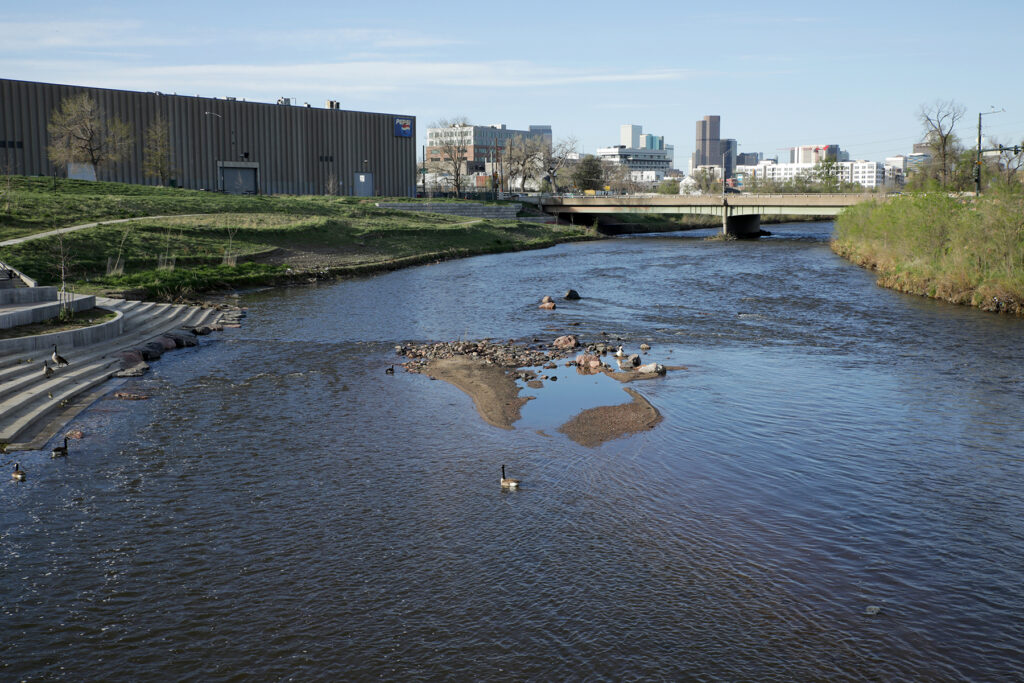
WHAT A RIVER REVEALS
A revitalized South Platte River will be a major feature of the National Western Center. Volunteers are already tallying a surprising variety of plants and animals on the riverway.
By Dan England | Jan. 3, 2022
AS HE VIEWED THE JUNGLE OF PLANTS before him three years ago, Greg Newman wondered if he had taken on a bit too much. He surveyed a section of the eastern bank of the South Platte River and found a tangle of nonnative trees and shrubs, including invasive buckthorn and tree of heaven. Some looked like they could have starred in Little Shop of Horrors, the film featuring a bizarrely overgrown (and hungry) houseplant.
Nearby, Newman had found heaps of trash littering shoals of riprap: There were shopping carts, plastic bottles, magazines, discarded clothing, and needles from injection drug use. Adding to the gritty scene, trains occasionally thundered across a nearby overpass. A chain-link fence and two above-ground sewer pipes hemmed in the riverbank, making it almost wholly inaccessible.
“I was alarmed by the sheer amount of debris and the degree to which the eastern bank was largely impassable. It was nothing you would associate with a healthy riparian corridor, offering natural habitat for plants and animals, much less a place people would want to visit,” Newman remembered. “I would almost call it dangerous.”
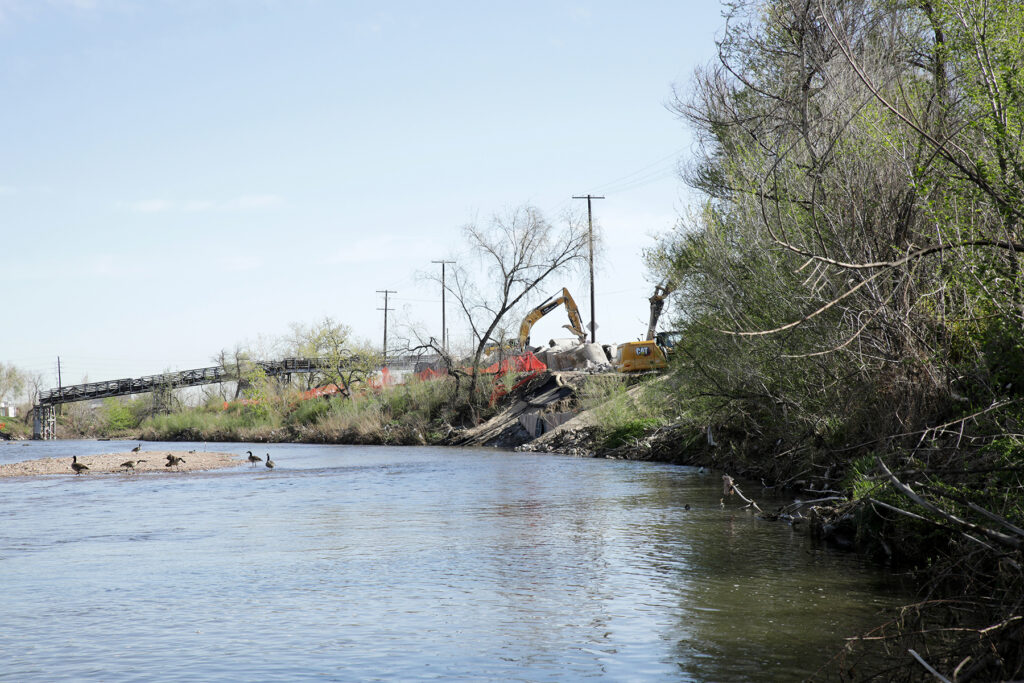
The city and county of Denver is leading cleanup and restoration of the South Platte River near the National Western Center, transforming the riverway into a key amenity at the complex. Photo: Vance Jacobs
That was the reality of the South Platte River as it coursed through north Denver near the interchange of I-25 and I-70 in 2019. Newman had signed on to lead a series of biological inventories – called bioblitzes – that would identify flora and fauna in a mile-long stretch of the South Platte riverfront near the National Western Center. At that moment, Newman could hardly imagine cataloging plants and animals along the South Platte: The river and its banks seemed like an urban wasteland, a place that had been used and abused through urbanization and the smelting, meatpacking, and railroad industries long associated with the area. It was closer to a blight than a healthy river.
But Newman was committed. He is a plant ecologist and research scientist with Colorado State University’s Natural Resource Ecology Laboratory, a unit devoted to research and education in ecosystem science. His regularly scheduled bioblitzes would rely on volunteer help to establish a baseline understanding of the plants and animals inhabiting an urban stretch of the South Platte River coinciding with its planned cleanup and restoration. The inventories would give neighboring communities and public officials a strong sense of river health before, during, and after reclamation. Such foundational knowledge helps gauge whether ecosystem rehabilitation is successful.
“The bioblitzes and river restoration go hand in hand because the bioblitzes keep track of biodiversity as restoration occurs over time,” Newman explained. “We want to document restoration success metrics.”
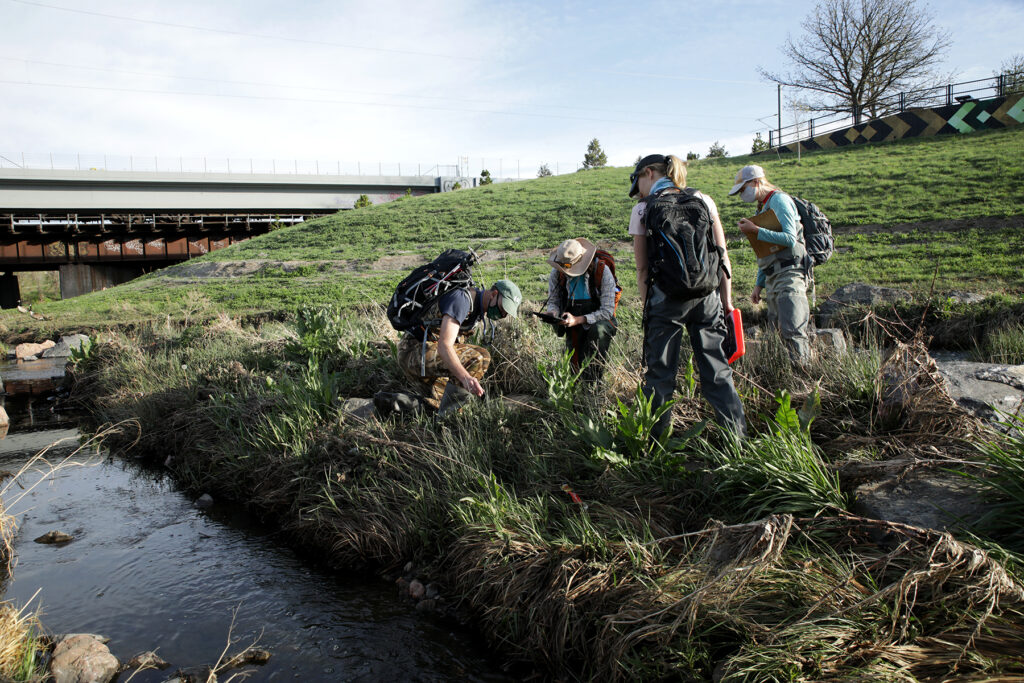
CSU plant ecologist Greg Newman, left, is leading a series of biological inventories, called bioblitzes, to understand plant and animal life on the riverfront. He is joined by botanist Jessica Smith, of the Colorado Natural Heritage Program, and biologists Pam Wegener and Erin Tessens, of Pinyon Environmental Inc. Photo: Vance Jacobs
The bioblitzes Newman would lead were timed with two monumental changes coming to the stretch of the South Platte River that runs through the Globeville and Elyria-Swansea neighborhoods, from Globeville Landing Park, off 38th Street, to Heron Pond Natural Area, off 53rd Avenue. First, the riverfront is undergoing extensive cleanup and restoration, led by the city and county of Denver and key partners; the work is within the broader Denver Urban Waterways Project, which involves the U.S. Army Corps of Engineers. Second, the National Western Center, a 250-acre site that abuts the river, is in the midst of redevelopment into a year-round site for public education, entertainment, and agribusiness innovation.
As part of riverfront restoration, the fence Newman encountered on the eastern bank of the South Platte was removed; two enormous sewer pipes that had blocked river access were replaced and buried; and rail lines, roadways, and bridges were reconfigured to open river access to neighboring communities and visitors. The remade riverfront will include re-engineered flood controls, recreation trails, and new gardens and park space. Over the course of several years, it will become an attractive and entirely different resource for the community and the National Western Center.
What’s more, Newman’s bioblitzes would be an advance program of the CSU Spur campus, the educational anchor of the National Western Center. Beginning in 2019 – three years before the CSU Spur campus would fully open – the biological inventories dove into hands-on scientific discovery, the exact kind of programming that the campus is being built to pursue. The Hydro building at Spur, largely devoted to water-related research and education, will adjoin the South Platte; its K-12 and public education programs will take advantage of this proximity when the building fully opens in late 2022.
“The bioblitzes are the epitome of the living laboratory concept at Spur. They provide an ongoing opportunity to engage in the natural world and learn about that world and, in the process, each other. This is one of the events that’s realizing the Spur vision of lifelong learning and community outreach,” Newman said. The bioblitzes are right in his wheelhouse: Newman directs a CSU program called CitSci, which provides citizen scientists and communities with technological tools to effectively collect, manage, and analyze data for their own research projects.
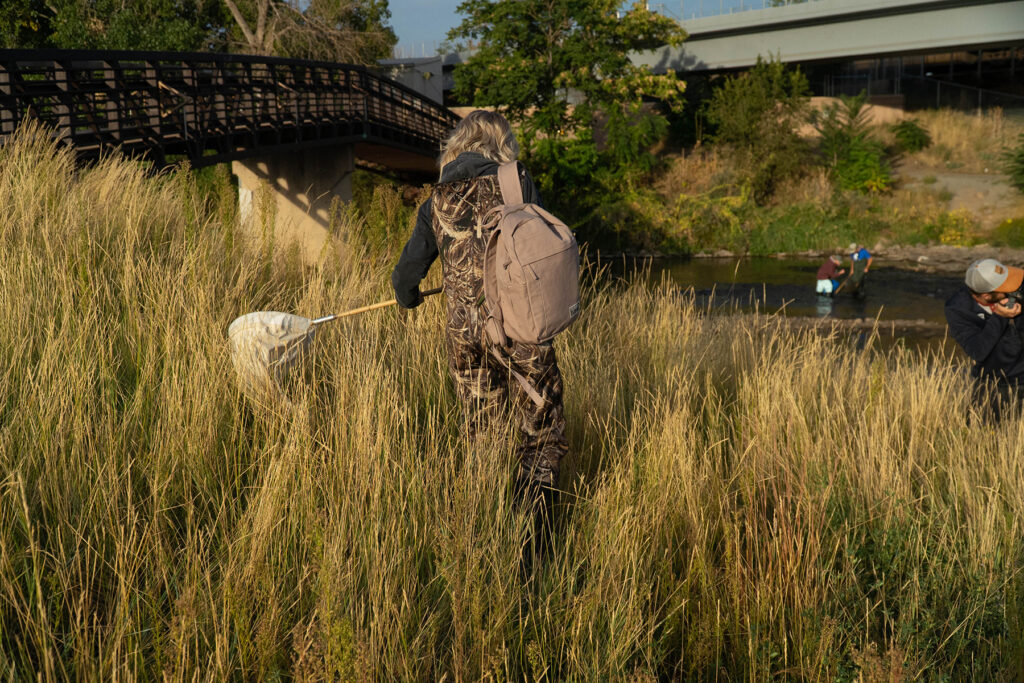
Bioblitz scientists and volunteers have logged hundreds of invertebrate species, from native butterflies to invasive clams. Many specimens are identified and kept in collection boxes and vials at the Butterfly Pavilion in Westminster to help record ecological changes as the South Platte riverfront undergoes restoration. Photo: Colorado State University System
Since 2019, when Newman first visited the South Platte near the National Western Center, he has helped lead four bioblitzes and already sees changes along the riverway as cleanup and restoration ramp up. So far, these inventories have involved mainly CSU faculty and staff, as well as employees with partner organizations, including the Butterfly Pavilion and Denver Zoo.
As restoration progresses, and the riverfront is reborn, the bioblitzes will occur multiple times each year and will invite neighborhood volunteers and other citizen scientists to join in. Newman calls it “community-based monitoring,” a science popularized by groups such as the National Audubon Society, which holds an annual Christmas Bird Count to catalog local bird populations. In a similar way, the South Platte bioblitz events will monitor the types and numbers of plant and animal species found during intensive, daylong or two-day inventory sessions: “Essentially, it’s counting up every living thing we see,” Newman said.
The bioblitzes are the epitome of the living laboratory concept at Spur. They provide an ongoing opportunity to engage in the natural world and learn about that world and, in the process, each other.
— Greg Newman, plant ecologist and research scientist, CSU Natural Resources Ecology Laboratory
And what have the first few bioblitzes discovered? A shockingly large number of species, Newman said. To wit: 142 plant species, 24 bird species, 506 insect species, and dozens of mammals. And that was before tallies from the most recent bioblitz last fall.
Although many of these plants and animals are exotics that tend to push out native species, large and growing numbers are the types scientists would hope to see in a natural river ecosystem at the juncture of the Rocky Mountain foothills and Great Plains, Newman noted. For instance, bioblitz participants have encountered hooded merganser, osprey, and yellow warblers – migrating birds that rely on the river as critical habitat in the Central Flyway. They’ve counted plant species native to the region, including sedges, golden currant, and Western wheatgrass. And most exciting of all: beaver, a cornerstone ecological species that will do wonders to boost river health.
“What we’ve learned through the bioblitzes makes me much more optimistic than I was during my first visit to this section of the river. It’s slowly on its way to a more naturalized state. The habitat the river provides – and will provide – will be significantly improved as restoration continues,” Newman said. River health has increased with recent redesign of Globeville Landing Park, removal of chain-link fencing, burial of sewer pipes at the National Western Center, and associated reseeding, he noted. “Anything that’s done to bring back vitality and life has a snowball effect,” he said.
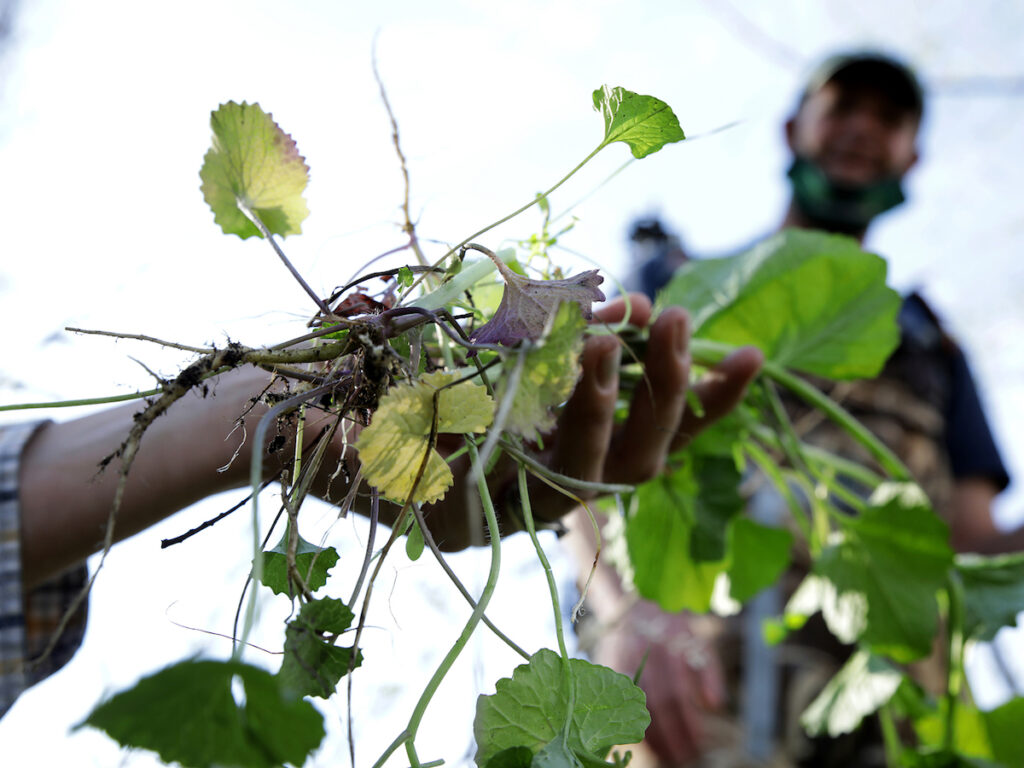
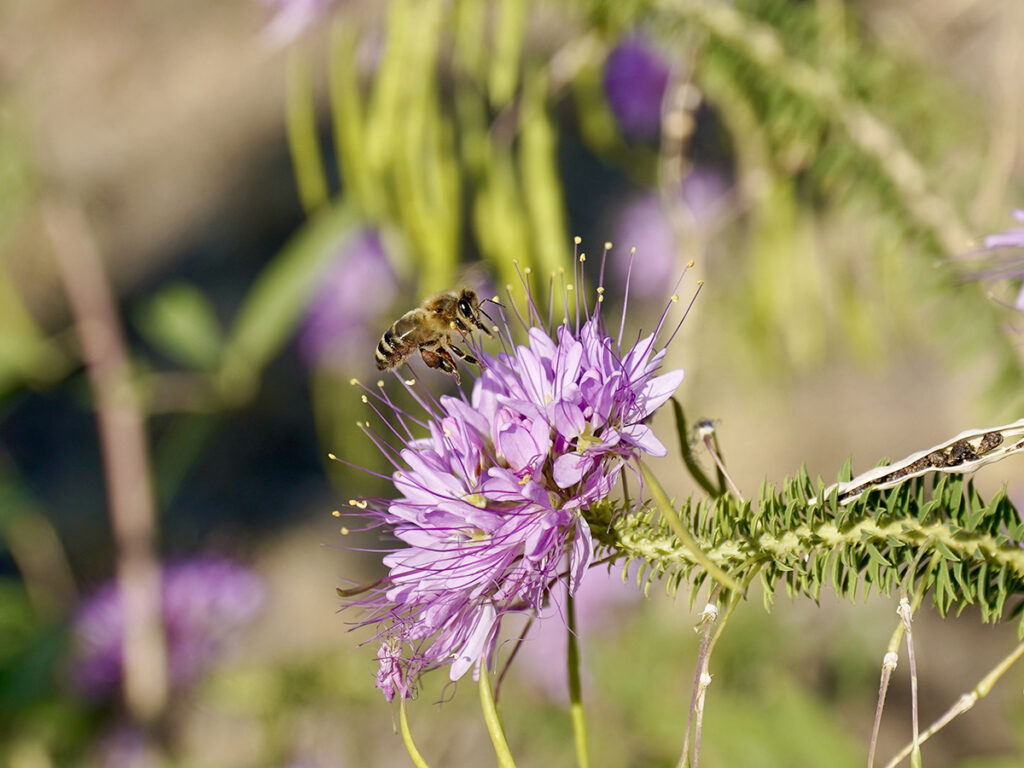
As riverfront restoration accelerates, bioblitz scientists are finding more signs of a healthy riparian corridor. Photography: Vance Jacobs; Colorado State University System
Those involved with South Platte rehabilitation hope the river will continue to gain ecological health and that people will eventually be able to safely swim and fish in the water. Much of the work will be completed by the latter half of 2022. Until then, participants in bioblitz events, organized by the CSU System, are eagerly logging evidence of change.
In late September last year, Newman strolled to the river with a team of about two dozen coworkers and volunteers. Ducks waded nearby. Insects clouded the air. Denver’s reseeding project was coming along nicely, and sandbars already were forming in the river, another sign of return to its natural state.
Lorna McCallister, an expert with the Butterfly Pavilion in Westminster, led a group focused on counting insects and other invertebrates. They dug holes, set traps with soapy water, and used nets to nab little creatures. Many of the insects caught would be frozen and pinned for inspection and accurate identification in Butterfly Pavilion laboratories, then saved in collection boxes as a permanent record of river life.
Several volunteers on the invertebrate team were students in a biology class at Community College of Denver. On the riverbanks, they found a number of Pieris rapae, or cabbage white butterfly, as well as common species of grasshoppers, beetles, and spiders.
“Get in there!” one student yelped, while capturing a specimen.
“Yay! I got one,” another one screamed.
“Sweet! A spider! Aww, he’s kind of cute,” a third student said.
From the river water, the team extracted crayfish, leeches, and, notably, Corbicula fluminea, or Asian clams. The clams, just a bit larger than a dime, are native to Asia and are invasive in many North American waterways, competing with native species for food and clogging intake valves at many power plants; they had not been previously recorded in that section of the South Platte, McCallister said. Many of the aquatic creatures would be preserved and identified in vials, also kept by the Butterfly Pavilion as a record of the river. The crayfish, though, were officially logged and added to pavilion exhibits for visitors to see.
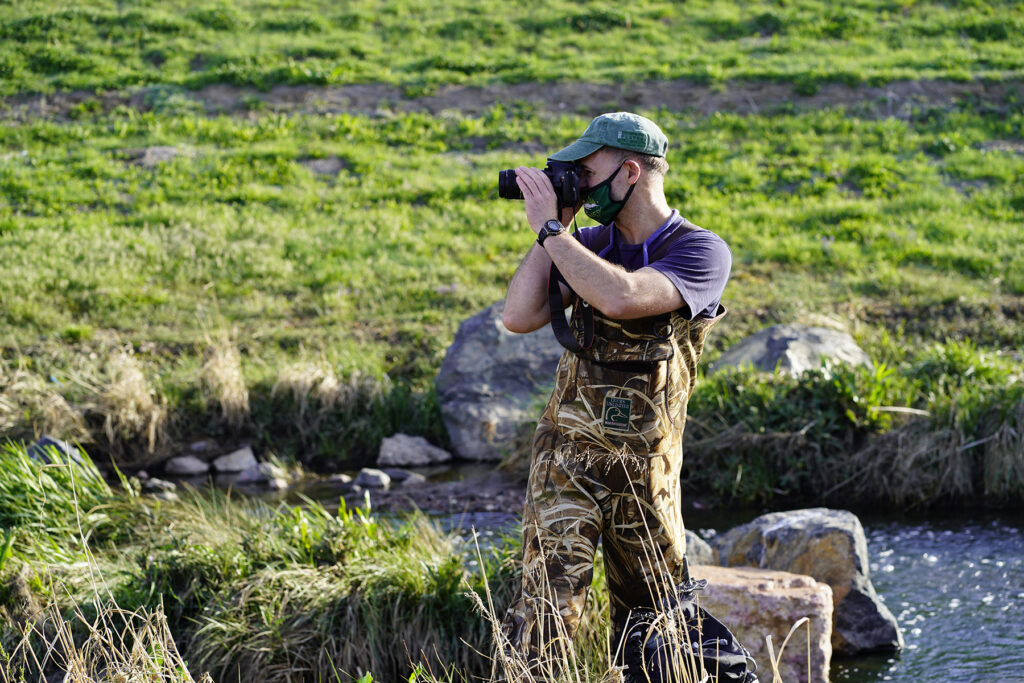
Above: Greg Newman foresees future bioblitzes involving both scientists and neighborhood residents in explorations of the South Platte. Below: A bioblitz team examines aquatic invertebrates. Photography: Vance Jacobs; Colorado State University System
As teammates worked their way down the river like water bugs, Newman’s botany team sifted through a salad of plants starting at Globeville Landing Park. There was no way the group could log every single plant encountered, Newman noted, but the day’s intensive counting would provide a solid snapshot of riverway biodiversity for use in comparisons over time.
“Look at that beautiful little flower,” Newman said softly, as he admired an Oenothera villosa, or hairy evening primrose.
Working alongside Newman were two ecologists from Pinyon Environmental, a Lakewood consulting firm involved with National Western Center redevelopment, and they kept Newman hopping as they noted plants for the tally.
“OK, I think we can finally move,” Newman said after logging at least 50 plants in the CitSci mobile app.
“Did you get this common mallow?” asked Erin Tessens, one of the Pinyon ecologists.
“No!” Newman said. “It’s hard to keep up with you all.”
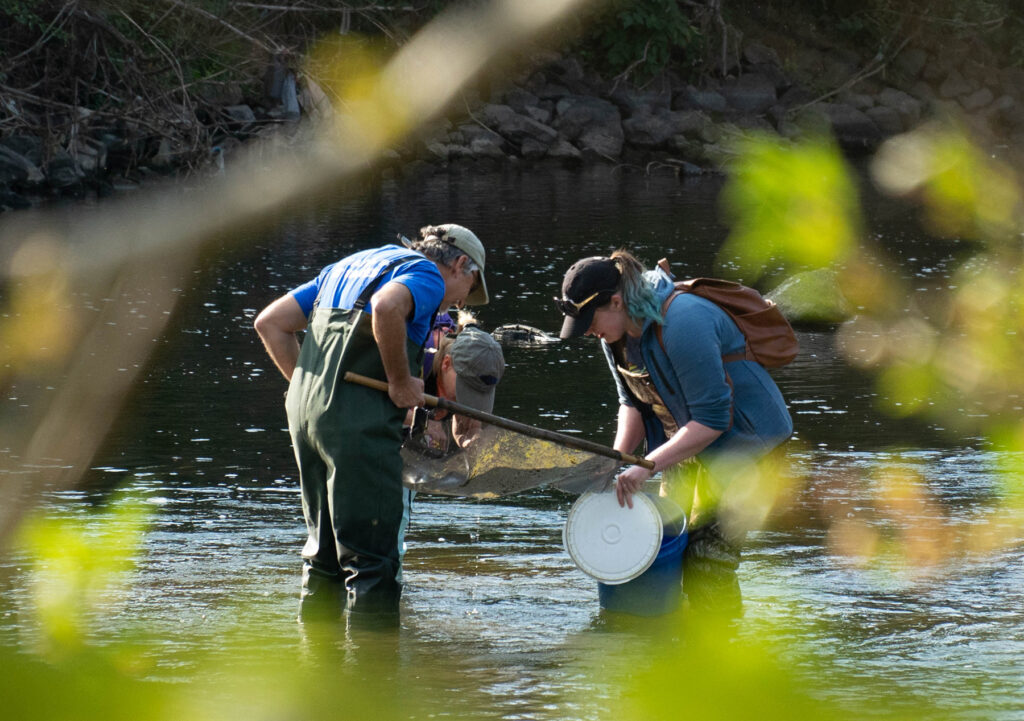
Among the partners in South Platte River restoration is the Greenway Foundation, a Denver nonprofit that has led robust efforts to reclaim the river and its tributaries from what it calls a “virtual cesspool” to a place of environmental and recreational pride. Joe Shoemaker started the foundation in 1974; his son, Jeff, now serves as executive director and carries forward his father’s belief that the South Platte can be a shining example of river restoration in Denver. The foundation has partnered with numerous public and private groups to create more than $500 million in South Platte environmental and recreational improvements.
“My dad said the best place to live and work would be along the South Platte River,” said Jeff Shoemaker, who served on the CSU System Board of Governors from 1999 to 2007. Restoration has a long way to go in many sections of the river that run through Metro Denver, he said, but improvements are evident as more stakeholders sign on to help. “We haven’t even crossed first base,” Shoemaker said of progress overall. “But I love, love, love what CSU has done. They will look upon the river as their back door at the CSU Spur campus. It’s the only river in town. It’s a pretty darn special place.”
Much of its special nature arises from the river’s history in Denver. In 1858, the city originated with a mining settlement on the South Platte River at what is now Grant-Frontier Park in South Denver; subsequent settlements were farther north on the river, near I-25 and Speer Boulevard.
The South Platte forms high in the Mosquito Range outside Fairplay, and has been important to the Arapaho and other Native people. During colonization, it was known for being a foot deep and a mile wide – a quintessential Great Plains river. Later, with urbanization and industrialization, the river was notably degraded and contaminated in Metro Denver. Yet, the South Platte remains the central feature of one of Colorado’s four major watersheds; it is an essential water source for all of northeastern Colorado, including Denver, and, after joining its northern tributary in Nebraska, flows on to the Missouri and Mississippi rivers.
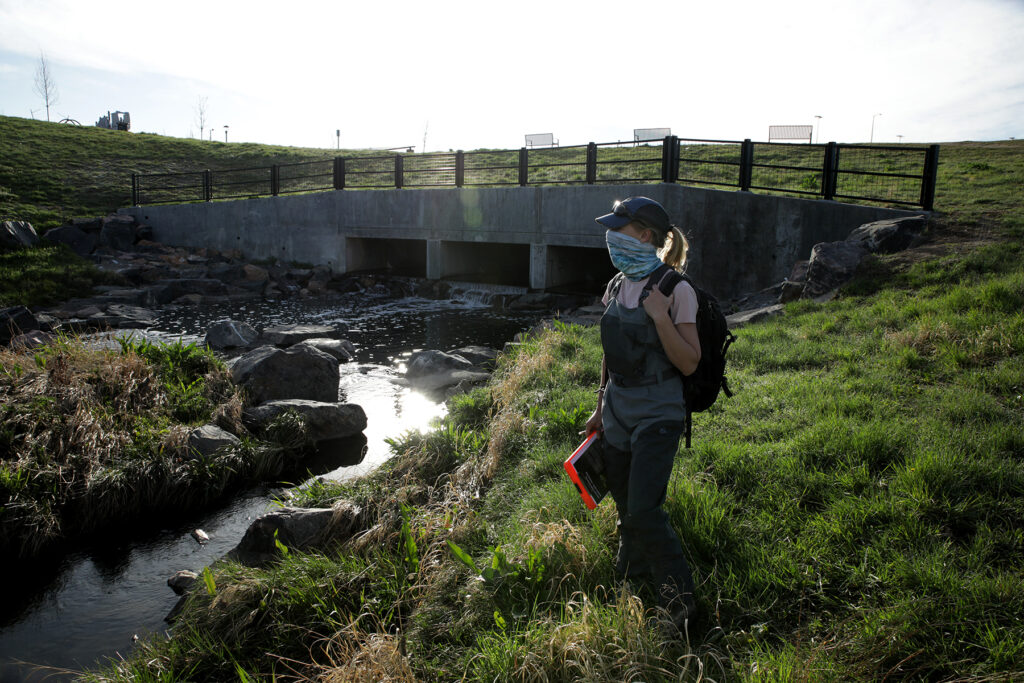
Pam Wegener, a biologist and watershed scientist with Pinyon Environmental Inc., helped with plant sampling during a recent bioblitz, starting on the South Platte at Globeville Landing Park in north Denver. Photo: Vance Jacobs
With cleanup of the South Platte near the National Western Center, residents in the Globeville and Elyria-Swansea neighborhoods have felt a glimmer of hope for their local waterway, said Lawrence Luevano, who has lived in the community for more than 20 years. Luevano has joined cleanup days led by the CSU System and said it’s heartening to see people take pride in the riverfront that has been neglected and shunned for so many years. “When we had the cleanup group out there, we were getting a lot of thank-yous,” Luevano said.
Developers of CSU Spur and the National Western Center anticipate ongoing improvements in the biodiversity of plant and animal life – and foresee a time when the river is once again an important amenity for visitors and neighboring communities. The bioblitzes will be there to record the changes.
“The bioblitzes can become community celebrations of life on the river, celebrations of a thriving ecosystem and neighborhood engagement,” Newman said. “I want people to eventually ask themselves, ‘What’s the river doing today?’”
SHARE

